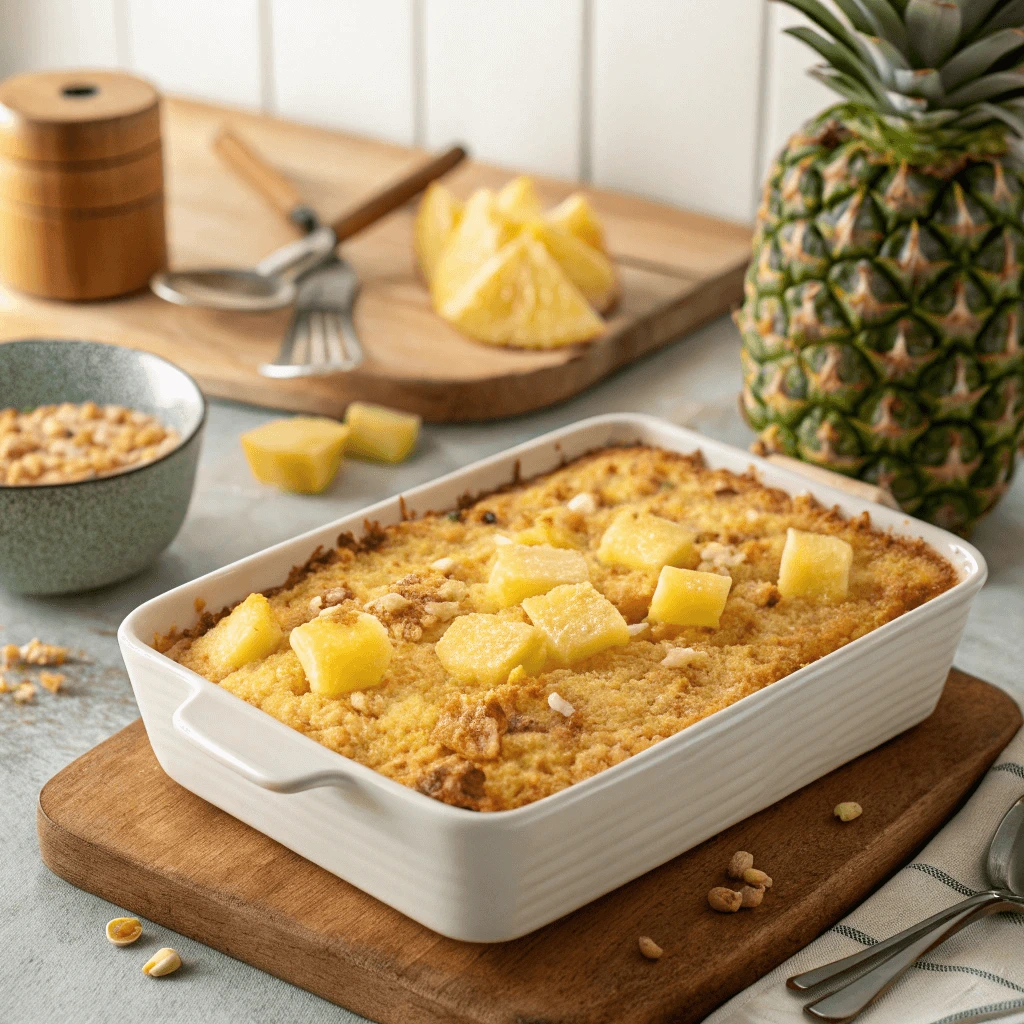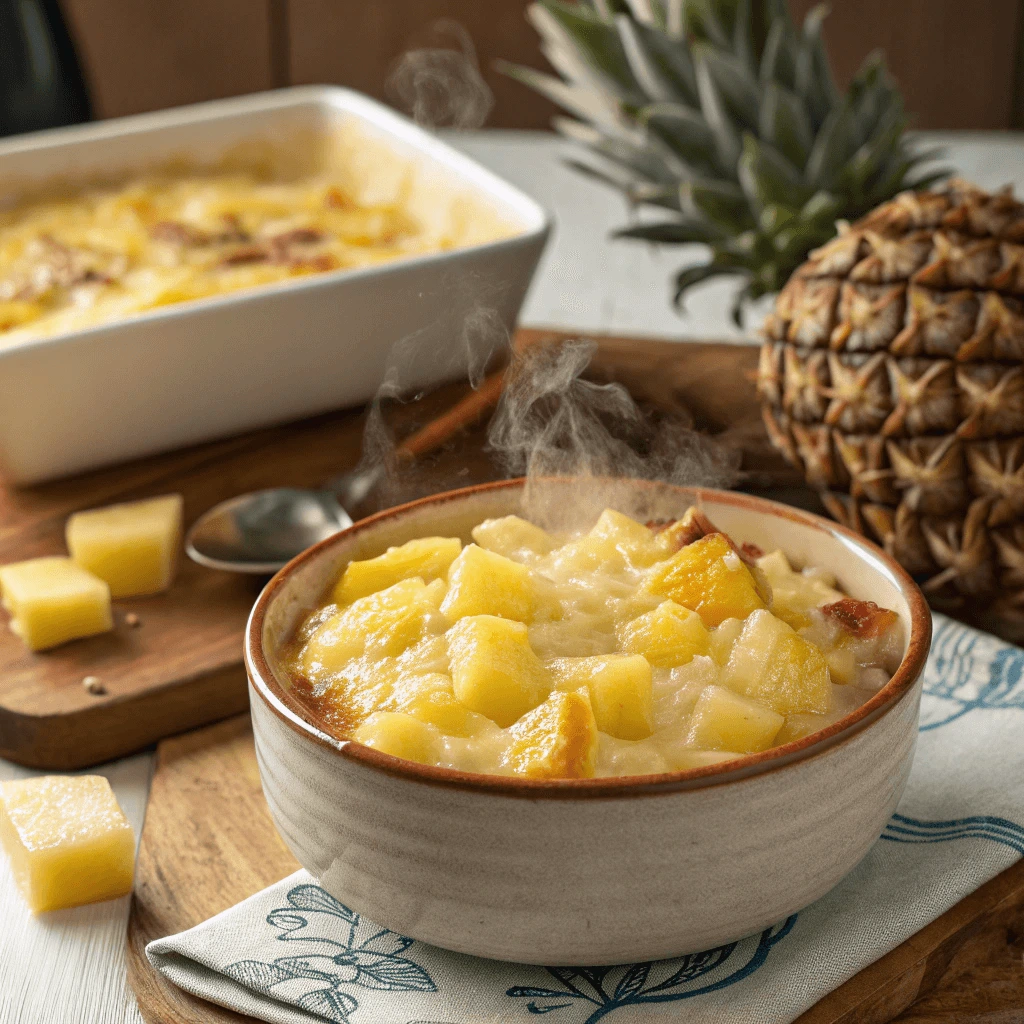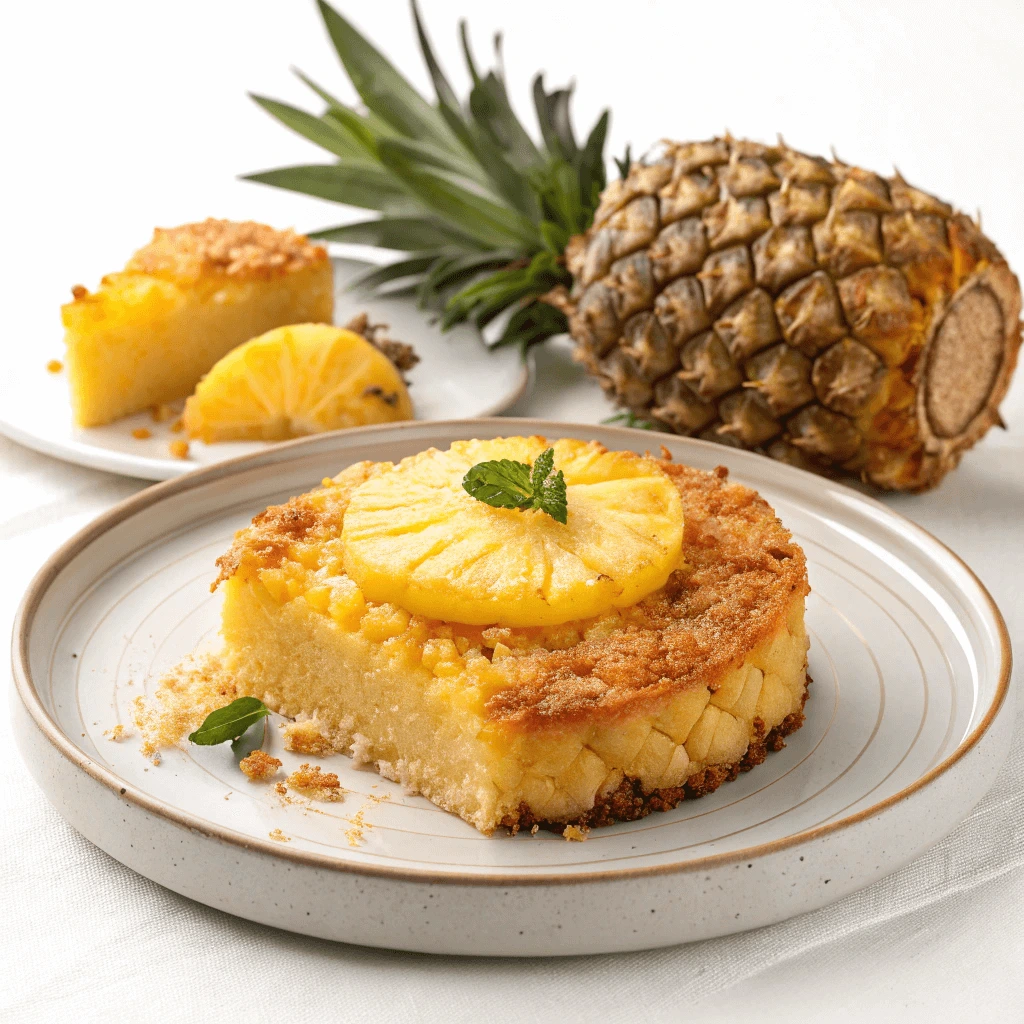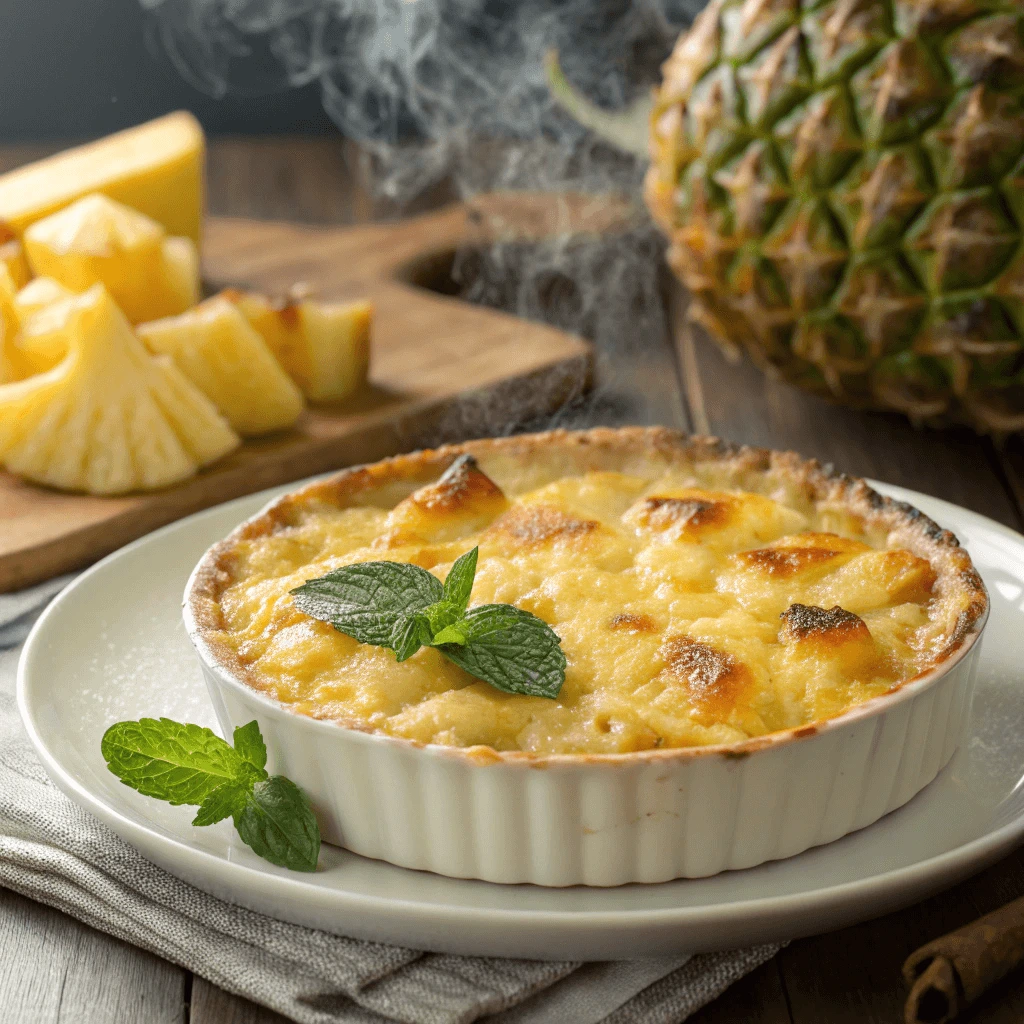Pineapple casserole is a classic Southern dish that combines the perfect balance of sweet and savory flavors in every bite. Whether you’re hosting a family dinner, celebrating a holiday, or simply craving comfort food, this easy-to-make casserole is sure to delight your taste buds. The best part? You don’t need to be a seasoned chef to create this delicious dish. With just a few simple ingredients like pineapple, cheese, butter, and crackers, you can whip up a flavorful casserole that’s both satisfying and unique. In this guide, we’ll walk you through each step of the process—from selecting the right ingredients to baking the casserole to perfection. Let’s dive into how to make pineapple casserole and enjoy a dish that’s perfect for any occasion!
Why Learning How to Make Pineapple Casserole Is Worth It

The Sweet and Savory Flavor That Delights Everyone
Pineapple casserole stands out because of its delicious blend of sweet and savory flavors. This mix creates a tasty balance that many people love.
Sweetness from Pineapple
Pineapple adds natural sweetness and a hint of tang. Whether fresh or canned, its juicy flavor brightens the casserole and balances the richer ingredients.
Savory Cheese and Butter
Cheddar cheese brings sharp, savory notes, while butter adds richness and creaminess. Together, they create a smooth and comforting base that pairs beautifully with the pineapple.
Crunchy Topping Adds Texture
A crispy cracker topping adds texture and a touch of saltiness. This crunchy layer contrasts with the creamy filling, making every bite satisfying.
The combination of these flavors and textures makes pineapple casserole a favorite side dish. Its sweet and savory harmony appeals to many tastes, perfect for family meals or gatherings.
How to Make Pineapple Casserole a Southern Favorite
Pineapple casserole has deep roots in Southern cuisine, where comfort food plays a central role in family and community gatherings. This dish combines familiar ingredients in a unique way that brings warmth and joy to any table.
Rich History and Southern Charm
This casserole reflects Southern culinary traditions by blending savory cheese with the sweetness of pineapple. Families across the South have passed down this recipe for generations, making it a beloved staple at many events.
Versatility for Various Gatherings
One of the reasons pineapple casserole remains popular is its versatility. It fits seamlessly into casual weeknight dinners, potlucks, and larger family celebrations. Its comforting flavors please diverse palates and complement a wide range of dishes.
Simple Yet Impressive
Despite its simplicity, this casserole impresses guests with its delicious taste and appealing presentation. It offers an easy way to elevate your meal without spending hours in the kitchen.
Pineapple casserole continues to be a go-to recipe in Southern homes and beyond. Its perfect balance of flavors and ease of preparation make it an excellent choice for any occasion.
Nutritious Twists on How to Make Pineapple Casserole
You can easily make your pineapple casserole healthier by swapping a few key ingredients. These simple changes boost nutrition without sacrificing flavor.
Choose Whole-Grain Crackers
Swap regular Ritz crackers for whole-grain versions. Whole-grain crackers provide more fiber and nutrients, which help keep you full longer and support digestion.
Use Low-Fat or Plant-Based Cheese
Opt for low-fat cheddar or try plant-based cheese alternatives. These choices reduce saturated fat and calories, making the casserole lighter and suitable for dairy-free diets.
Select Unsweetened or Fresh Pineapple
Pick unsweetened canned pineapple or fresh pineapple instead of sweetened canned varieties. This lowers added sugar and adds natural freshness and vitamins.
Substitute Butter with Healthier Fats
Replace butter with olive oil or coconut oil to cut down on saturated fats. These healthy fats add richness and support heart health.
Ingredients to Make the Best Pineapple Casserole

Must-Have Staples for How to Make Pineapple Casserole
This pineapple casserole recipe relies on a few essential pantry staples that come together to create its unique sweet and savory flavor. Understanding the role of each ingredient helps you appreciate why these staples are so important.
The Star Ingredient: Pineapple
Pineapple provides the perfect balance of sweetness and acidity in this dish. Using canned pineapple chunks or crushed pineapple adds juicy bursts of tropical flavor. Make sure to drain the pineapple well to avoid excess liquid, which could make the casserole soggy. Fresh pineapple can also work if you prefer a natural, less processed taste.
Cheddar Cheese: The Savory Counterpart
Sharp cheddar cheese complements the sweetness of the pineapple with its rich, tangy flavor. It melts beautifully in the casserole, creating a creamy texture that ties the dish together. Choosing a good-quality cheddar ensures your casserole has the right depth of flavor. You can experiment with mild or extra sharp cheese depending on your preference.
Ritz Crackers: The Crunchy Topping
Ritz crackers provide the classic buttery crunch that contrasts with the soft pineapple and cheese base. Crushing the crackers finely and mixing them with melted butter before sprinkling on top creates a golden, crispy layer once baked. If you want a lighter option, whole-grain crackers can add extra fiber and nutrients without losing the crunch.
Optional Flavor Enhancers
Adding optional flavor enhancers can elevate your pineapple casserole from simple to sensational. These ingredients introduce new layers of taste, balancing sweetness and savory notes while adding complexity to the dish.
Warm Spice with Nutmeg
Nutmeg offers a warm, slightly sweet aroma that blends beautifully with the pineapple and cheese. A small pinch adds depth without overpowering the dish. Many Southern cooks use nutmeg to give casseroles a cozy, comforting feel. Sprinkle it evenly into the cheese and pineapple mixture before baking to infuse that subtle warmth throughout.
Sweet and Earthy Cinnamon
Cinnamon enhances the natural sweetness of the pineapple with its earthy, spicy undertones. Just a dash can make a big difference in flavor. When combined with nutmeg, cinnamon creates a nostalgic, homey aroma reminiscent of classic comfort foods. Mix cinnamon into the base or sprinkle a little on top of the cracker topping for a hint of spice.
Fresh and Savory Green Onions
Green onions introduce a fresh, savory contrast that balances the sweetness of the pineapple. Chop them finely and fold them into the pineapple and cheese base or sprinkle them over the top before baking. Their mild onion flavor adds brightness and a slight crunch, enhancing the overall texture.
Healthy Substitutes
If you want to enjoy a delicious pineapple casserole while keeping it healthier, consider using these smart substitutes. They help reduce added sugars, unhealthy fats, and excess sodium, making the dish more nutritious without sacrificing flavor.
Unsweetened Pineapple: Cut Down on Added Sugar
Many traditional recipes call for canned pineapple packed in syrup, which adds unnecessary sugar. Switching to unsweetened pineapple chunks or fresh pineapple allows you to control the sweetness level naturally. Unsweetened pineapple still provides the juicy, tropical flavor your casserole needs, but with fewer calories and less sugar. You can also drain fresh pineapple juice before adding it to avoid excess moisture.
Plant-Based Butter: A Healthier Fat Alternative
Butter adds richness and moisture to the casserole, but it also contains saturated fat. Replacing regular butter with plant-based butter or margarine lowers saturated fat intake and introduces healthier fats, such as those from oils like olive or avocado. These alternatives melt well and provide a creamy texture. When choosing plant-based butter, look for options with minimal additives and no hydrogenated oils to keep your dish wholesome.
Low-Sodium Crackers: Control Your Salt Intake
The cracker topping traditionally uses Ritz crackers, which can contain higher sodium levels. Opting for low-sodium crackers or whole-grain varieties can reduce the salt content while adding fiber and nutrients. Whole-grain crackers often bring a nuttier flavor and better crunch, enhancing the casserole’s texture. You can crush the crackers yourself to ensure freshness and portion control.
Step-by-Step Instructions on How to Make Pineapple Casserole

Preparing the Pineapple and Cheese Base
Creating the perfect pineapple and cheese base is essential for a delicious pineapple casserole. This step blends the sweetness of pineapple with the creamy, savory richness of cheese, forming the heart of the dish.
Choosing the Right Pineapple
Start by selecting pineapple that suits your taste and texture preferences. You can use canned pineapple chunks, preferably in juice or unsweetened, or fresh pineapple that you have peeled and chopped yourself. Fresh pineapple offers a vibrant flavor and juicy texture, while canned pineapple provides convenience and consistency. Drain the pineapple well to avoid excess liquid, which can make the casserole soggy.
Combining Pineapple with Cheese
In a mixing bowl, combine the drained pineapple chunks with shredded cheddar cheese. Sharp cheddar works best because it offers a bold, tangy flavor that balances the pineapple’s sweetness. Mixing the two ingredients thoroughly ensures every bite delivers that classic sweet-and-savory taste.
Adding Creamy Elements
To create a smooth and rich texture, incorporate creamy ingredients such as sour cream, cream cheese, or mayonnaise. These ingredients help bind the pineapple and cheese, giving the casserole a luscious consistency. Whisk or stir the cream element until smooth before folding it into the pineapple-cheese mixture. This step ensures even distribution of flavor and texture throughout the base.
Seasoning the Mixture
Add a pinch of salt and pepper to enhance the flavors. Some recipes call for a small amount of sugar to boost the sweetness, but this depends on your preference and the pineapple’s natural sweetness. Stir gently but thoroughly to combine the seasoning evenly.
Making the Cracker Topping and Baking Instructions
The cracker topping adds a crunchy contrast to the creamy pineapple and cheese base, making it an essential part of this casserole.
Preparing the Topping
Start by crushing Ritz crackers into coarse crumbs. You can do this using a rolling pin or food processor. Then, melt some unsalted butter and mix it well with the crushed crackers. The butter helps the topping brown nicely and stick together during baking.
Applying and Baking
Spread the cracker mixture evenly over the pineapple and cheese base in your baking dish. Preheat your oven to 350°F (175°C), then bake the casserole for 25 to 30 minutes. The topping should turn golden brown, and the casserole will bubble at the edges.
If the topping browns too quickly, cover it loosely with foil to prevent burning. After baking, let the casserole rest for a few minutes before serving to help it set.
Healthy Cooking Tips
Making your pineapple casserole healthier doesn’t mean sacrificing flavor. By adjusting some ingredients, especially butter, you can enjoy a lighter yet delicious dish.
Cutting Down on Butter
Butter adds richness and moisture to the casserole, but it also increases the fat and calorie content. To reduce butter without losing taste, try using less than the recipe calls for—cutting it by one-third is a good start. You can also replace some butter with heart-healthy oils like olive oil or avocado oil, which provide healthy fats while maintaining a smooth texture.
Choosing Plant-Based Butter Alternatives
Plant-based butters, such as those made from coconut oil or blends of vegetable oils, offer dairy-free options that work well in casseroles. These alternatives often contain less saturated fat and can add subtle flavors. When substituting, use the same amount as you would with regular butter for best results.
Incorporating Other Healthy Fats
Besides butter substitutes, you can add mashed avocado or nut butters in small amounts to enhance creaminess and nutrition. These provide beneficial fats and contribute to a unique twist on the traditional casserole.
Additional Tips for Healthier Cooking
- Use low-fat or reduced-fat cheese to lower saturated fat intake.
- Choose unsweetened or lightly sweetened pineapple to reduce added sugars.
- Experiment with whole-grain or low-sodium crackers for the topping to increase fiber and cut down on salt.
Serving Ideas After You Make Pineapple Casserole
Perfect Occasions
Pineapple casserole shines at a variety of gatherings thanks to its warm, comforting flavor and easy prep.
Great for Family Dinners
This dish brings comfort and nostalgia to the dinner table. Its blend of sweet pineapple and savory cheddar cheese appeals to both kids and adults. Because it’s simple to prepare, it makes a great weeknight side dish—but it also feels special enough for weekend family meals. Pair it with roasted veggies or grilled tofu for a well-rounded, meat-free dinner.
A Potluck Crowd-Pleaser
When you bring pineapple casserole to a potluck, it always stands out. The rich, golden cracker topping and unique flavor draw attention. It travels well, stays delicious at room temperature, and complements many other dishes. You can bake it in a disposable tray for convenience and easy cleanup.
Make-Ahead Friendly
Hosting or attending a gathering can get hectic. Luckily, pineapple casserole can be made ahead of time. Just assemble it the night before, store it in the fridge, and bake it when you’re ready. This flexibility makes it ideal for holidays, potlucks, and casual get-togethers alike.
Meat-Free Side Dishes That Complement Pineapple Casserole
Pineapple casserole offers a sweet and savory bite, making it a versatile dish that pairs beautifully with a variety of meat-free sides. Whether you’re hosting vegetarians or simply lightening up your meal, these pairings will elevate your table.
Roasted Vegetables
Roasted vegetables like Brussels sprouts, sweet potatoes, or carrots bring earthiness and a bit of crunch that balance the creamy texture of pineapple casserole. Season the veggies with herbs like rosemary or thyme to deepen their flavor. Roasting also enhances their natural sweetness, which complements the casserole’s pineapple.
Grilled or Baked Tofu
Tofu serves as a protein-rich partner without overpowering the main dish. Grilled tofu adds a smoky note, while baked tofu with a soy or citrus glaze plays nicely with the casserole’s tropical touch. Choose firm tofu and marinate it well to lock in flavor.
Quinoa or Brown Rice Pilaf
Light grain-based sides like quinoa or brown rice pilaf bring fiber and texture to the plate. Add sautéed mushrooms, spinach, or slivered almonds for more dimension. These grains absorb sauces and juices well, making them an ideal canvas alongside pineapple casserole.
Fresh Salads and Roasted Vegetables as Healthy Serving Ideas
Pineapple casserole is rich, cheesy, and flavorful, so pairing it with lighter sides like fresh salads and roasted vegetables creates a well-rounded and satisfying meal. These sides offer balance in both nutrition and flavor, while also adding texture and visual appeal to your plate.
Why Fresh Salads Work So Well
Fresh salads are crisp, light, and refreshing. They cleanse the palate and help cut through the richness of the casserole. A simple green salad with baby spinach, romaine lettuce, or arugula pairs beautifully. Toss it with cherry tomatoes, sliced cucumbers, and a light vinaigrette for a quick, healthy side.
For a fruity twist, try a citrus salad with orange slices, pomegranate seeds, and a honey-lime dressing. This combination complements the pineapple’s natural sweetness and adds a bright, zesty flavor to your meal.
The Comfort of Roasted Vegetables
Roasted vegetables bring warmth and a touch of smokiness to the table. Vegetables like carrots, Brussels sprouts, sweet potatoes, and zucchini roast well and deliver a natural sweetness that echoes the pineapple in the casserole.
Drizzle your veggies with olive oil, season with garlic and black pepper, and roast them until golden brown. Their crispy edges and tender centers contrast nicely with the creamy casserole base.
A Balanced Meal with Flavor and Nutrition
Combining a hearty pineapple casserole with a light salad and warm veggies makes your meal more nutritious and visually inviting. These sides are full of fiber, vitamins, and antioxidants, offering a wholesome boost without taking away from the star of the show—your casserole.
Tips, Storage, and Recipe Variations
Storage and Reheating Tips to Keep Your Casserole Fresh
Pineapple casserole is one of those comforting dishes that tastes great fresh out of the oven—and just as satisfying the next day when stored and reheated properly. Taking the right steps ensures you preserve both the flavor and texture.
Storing Leftovers the Right Way
Once your casserole cools to room temperature, store it in an airtight container or tightly cover the baking dish with foil or plastic wrap. Keep it in the refrigerator and consume within 3 to 4 days. This helps maintain freshness and food safety.
Can You Freeze Pineapple Casserole?
Yes! For longer storage, freeze individual portions in airtight, freezer-safe containers or wrap them in foil. This makes future reheating quicker and easier. Try to use the frozen casserole within 1 to 2 months for the best quality.
Reheating for Best Results
To reheat, preheat your oven to 350°F (175°C). Cover the casserole with foil and bake for about 15–20 minutes. Remove the foil for the last few minutes to crisp up the topping.
If using a microwave, cover the portion with a damp paper towel and heat in short bursts until warmed through.
Making It More Nutritious: Adding Veggies and Using Alternative Ingredients
You can make your pineapple casserole both delicious and healthier with a few simple changes. By adding vegetables and using better-for-you ingredients, the dish becomes more balanced without losing its comforting flavor.
Add Nutritious Vegetables
Try adding finely chopped vegetables like bell peppers, zucchini, or spinach. These options bring extra vitamins, fiber, and texture. Lightly sauté the vegetables first to remove excess moisture, then mix them into the casserole base.
Use Lower-Fat and Plant-Based Options
Swap out regular cheese with low-fat or plant-based cheese to reduce saturated fat. Instead of full-fat butter, use plant-based butter or a small amount of olive oil to keep it heart-healthy.
Choose Smarter Staples
For the pineapple, go with unsweetened canned pineapple in its own juice or use fresh pineapple to cut down on added sugar. Replace standard crackers with whole-grain or low-sodium versions to boost fiber and reduce salt.
These changes make your pineapple casserole lighter, more wholesome, and still just as satisfying.
Dairy-Free and Vegan Variations, Plus Using Fresh Pineapple Instead of Canned
Creating a dairy-free or vegan version of pineapple casserole is simple and satisfying. With the right substitutions, you can keep all the sweet and savory goodness while meeting dietary needs.
Use Dairy-Free Cheese Alternatives
Swap out traditional cheddar with vegan cheese shreds made from almonds, cashews, or coconut oil. Choose varieties that melt well and have a tangy flavor to mimic cheddar. Many brands now offer excellent dairy-free options that work well in casseroles.
Replace Butter with Plant-Based Spreads
Instead of butter, use vegan margarine or plant-based butter alternatives. Coconut oil also adds richness and blends nicely with the tropical notes from the pineapple. Always check labels to ensure there are no hidden animal-derived ingredients.
Choose Fresh Pineapple for a Natural Touch
Using fresh pineapple instead of canned not only enhances flavor but also avoids added sugars and preservatives. Chop the pineapple into small, bite-sized pieces and drain off any excess juice to avoid a soggy casserole.
Opt for Vegan Crackers or Gluten-Free Options
Many regular crackers contain dairy, so choose vegan-friendly, gluten-free, or whole-grain varieties. Look for brands that skip butter and use natural seasonings to keep your dish both crunchy and compliant with dietary needs.
With these swaps, your pineapple casserole becomes a wholesome, plant-based version that everyone at the table can enjoy—whether they’re vegan, lactose-intolerant, or just looking to eat a little healthier.
Conclusion
Pineapple casserole is the perfect blend of sweet and savory, offering a comforting dish that’s both simple to prepare and endlessly delicious. Whether you’re making it for a family dinner, a potluck, or just a cozy meal at home, this recipe brings warmth and flavor to any table. With easy steps, wholesome ingredients, and options for healthy or plant-based swaps, it’s a versatile dish everyone can enjoy. Give this pineapple casserole a try—you’ll be surprised just how quickly it becomes a household favorite!
